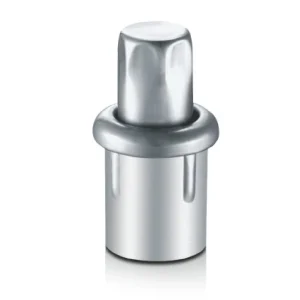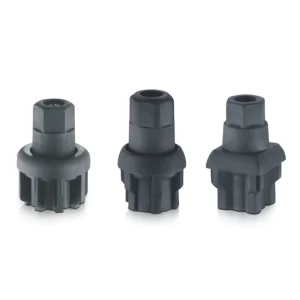5 Days a week from 8:30 am to 5:30 pm
Rubber or Stainless Steel? A Detailed Look at Bullet Feet Material Selection
Bullet feet steady restaurant gear, but selecting between rubber and steel affects function and durability. This guide examines their traits, strengths, and weaknesses to aid your choice. Learn key factors guiding material decisions and why SIMPLE Kitchenware is your reliable source for top-quality bullet feet.
What Are the Key Characteristics of Rubber Bullet Feet?
Rubber bullet feet are commonly used in commercial kitchens for their distinct qualities. They provide clear benefits but also have drawbacks. Below, we delve into these features in detail.
Properties of Rubber as a Material
Rubber, often a pliable substance, is a soft, non-metal material. It shines in soaking up shocks. It also returns to its initial shape. This improves steadiness. Moreover, it blocks electrical currents. This ensures safety near electrical devices. Its strong grip stops sliding on slick surfaces. Additionally, its lighter weight compared to metals eases setup. These traits make rubber a flexible option for bullet feet in diverse environments.
Advantages of Rubber Bullet Feet
Noise Reduction Capabilities
Rubber’s flexibility muffles sound, making it perfect for bustling kitchens where equipment shifts create noise.
- Sound Dampening: Rubber lessens rattling when tables or sinks are moved or bumped.
- Worker Ease: Quieter settings foster a more comfortable workplace.
- Guest Enjoyment: Calmer kitchens improve the dining vibe in open-layout eateries.
For noise-conscious venues, check SIMPLE’s all-rubber bullet feet for effective sound management.
Vibration Absorption and Stability
Rubber’s capacity to soak up vibrations keeps equipment steady, even during intense use.
- Vibration Control: Rubber reduces shakes from blenders or cutters, extending equipment life.
- Anti-Slip Feature: Strong traction secures gear on wet or greasy floors.
- Floor Protection: Rubber avoids scratches on fragile surfaces, great for rented spaces.
These qualities make rubber bullet feet a prime pick for stability-driven needs.
Limitations of Rubber Bullet Feet
Despite their strengths, rubber bullet feet have flaws that may impact their fit.
Durability Challenges in High-Pressure Settings
Rubber’s pliability can create problems in severe conditions.
Wear: Heavy weights or constant motion may cause rubber to split or distort.
Chemical Decay: Contact with oils, grease, or detergents can gradually erode rubber.
Weight Restriction: Rubber typically bears less load (100-200 kg) compared to metal options.
In demanding kitchen environments, rubber may need frequent replacement. This raises ongoing costs.
How Do Stainless Steel Bullet Feet Perform in Comparison?
Steel bullet feet are a sturdy alternative, offering unique benefits and challenges. Their robust qualities suit heavy-duty tasks but may not fit every case.
Properties of Stainless Steel as a Material
Steel, often 304 or 316 grades, is a rust-resistant alloy with remarkable strength. Its qualities include:
- Toughness: High strength supports heavy loads without bending.
- Rust Resistance: Chromium forms a protective layer, preventing corrosion.
- Clean Surface: Non-porous steel stops germ growth, ideal for food safety.
- Heat Tolerance: Steel endures extreme hot or cold without breaking down.
These features make steel a top-tier choice for bullet feet in commercial kitchens.
Advantages of Stainless Steel Bullet Feet
Strength and Durability
Steel’s toughness ensures lasting performance.
- High Weight Capacity: Supports up to 800-1000 kg, ideal for heavy gear like fryers.
- Impact Resistance: Withstands dents or harm from accidental knocks.
- Longevity: Steel feet stay intact for years, cutting replacement needs.
SIMPLE’s all-steel bullet feet are built for maximum strength in busy kitchens.
Resistance to Corrosion and Wear
Steel’s resistance to environmental factors boosts its fit for kitchens.
- Rust Protection: Resists moisture, grease, and cleaning agents without rusting.
- Wear Resistance: Keeps a sleek finish despite regular cleaning.
- Food Safety: Non-porous surfaces meet strict hygiene rules.
These traits make steel perfect for wet or chemical-heavy areas.
Limitations of Stainless Steel Bullet Feet
Though sturdy, steel bullet feet have downsides that may sway your decision.
Potential for Noise Generation
Steel’s firmness can increase noise in active kitchens.
- Clanking Noises: Metal-on-metal contact creates louder sounds when gear is shifted.
- Vibration Transfer: Steel passes vibrations, possibly loosening parts over time.
- Worker Distraction: Louder noise may disrupt focus in high-pressure kitchens.
Noise-sensitive kitchens may need extra sound-dampening with steel feet.
Higher Cost Implications
Steel’s superior qualities come at a higher price.
- Initial Expense: Steel feet cost 20-30% more than rubber options.
- Setup Costs: Heavier steel may need special tools or labor.
- Budget Limits: Higher upfront costs may challenge small restaurant funds.
Despite the cost, steel’s durability often proves worthwhile for long-term use.
Which Factors Should Influence Your Choice Between Rubber and Stainless Steel?
Choosing the right bullet feet hinges on your kitchen’s needs, setting, and budget.
Application-Specific Requirements
The planned use of bullet feet greatly affects material choice.
Industrial vs. Residential Use Cases
- Industrial Kitchens: Busy eateries gain from steel’s sturdiness and cleanliness. Heavy gear like ovens or prep tables needs steel’s weight support.
- Residential or Small Cafes: Rubber bullet feet fit lighter gear, like coffee makers, where noise control and floor care matter most.
- Mixed Use: Hybrid kitchens may use rubber for front-of-house gear and steel for back-of-house heavy equipment.
Evaluate your gear’s weight and usage frequency to pick the best material.
Environmental Considerations
Kitchen conditions play a vital role in material performance.
Exposure to Moisture, Chemicals, or Extreme Temperatures
- Moisture: Steel thrives in damp areas, resisting rust in dishwashing zones. Rubber may break down in constant wetness.
- Chemicals: Steel endures harsh cleaners and grease, while rubber may wear out.
- Temperature Extremes: Steel handles high-heat zones near ovens (up to 250°C) or cold storage (-70°C). Rubber works well in mild temperatures but may crack in extreme cold.
Assess your kitchen’s exposure to these elements to ensure material durability.
Cost vs. Performance Trade-Offs
Balancing cost and function is key for budget-aware operations.
- Initial Costs: Rubber is more affordable upfront, ideal for startups or small venues.
- Long-Term Savings: Steel’s sturdiness cuts replacement costs, benefiting high-volume kitchens.
- Upkeep Needs: Rubber demands frequent wear checks, while steel needs little maintenance.
Consider your budget and operational scale to find the best value. For varied options, explore SIMPLE’s bullet feet collection.
Why Is SIMPLE a Reliable Supplier for Bullet Feet?
Overview of SIMPLE’s Expertise in Bullet Feet Manufacturing
SIMPLE Kitchenware is a top provider of commercial kitchen gear, excelling in sturdy, high-performance bullet feet. With years of expertise, SIMPLE blends advanced production with strict quality checks to deliver dependable products suited to restaurant needs.
Customer Support and Industry Reputation
SIMPLE is known for outstanding customer service and industry trust.
- Expert Advice: Dedicated support helps you pick the right bullet feet for your needs.
- Swift Delivery: Fast shipping minimizes downtime for your operations.
- Trusted Name: Partnerships with leading eateries worldwide show SIMPLE’s reliability.
Choosing SIMPLE ensures access to premium products and exceptional support.
Summary of Key Insights on Material Selection
Rubber bullet feet offer noise reduction, vibration absorption, and cost-effectiveness. They suit light-duty or sound-sensitive environments. Yet, their durability falters in high-pressure or chemical-rich settings. Steel bullet feet provide exceptional toughness, corrosion resistance, and hygiene. They’re ideal for heavy-duty kitchens. However, they generate louder noise and cost more. Your decision hinges on application, conditions, and budget. SIMPLE Kitchenware supplies both materials. It ensures quality and reliability for any restaurant.
FAQs About Rubber and Stainless Steel Bullet Feet
What Are the Maintenance Requirements for Each Material?
- Rubber: Check monthly for cracks or chemical wear. Clean with mild soap to prevent erosion. Replace every 1-2 years in busy settings.
- Steel: Wipe with a damp cloth to keep clean. Inspect fittings quarterly. Steel needs minimal upkeep and lasts 5+ years.
Can Rubber or Stainless Steel Be Used in Extreme Temperature Conditions?
- Rubber: Fits moderate temperatures (-20°C to 60°C). Extreme heat or cold may cause cracking or stiffening.
- Steel: Thrives in extreme conditions (-70°C to 250°C), ideal for ovens or freezers.
How Do I Determine the Right Size and Type of Bullet Feet for My Needs?
- Measure Tubing: Ensure fit with equipment legs (e.g., 1-5/8” O.D.).
- Assess Weight: Pick feet with enough capacity (e.g., 300 kg for fryers).
- Consider Setting: Choose rubber for noise control or steel for wet areas. Explore SIMPLE’s bullet feet rangefor tailored options.



